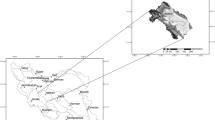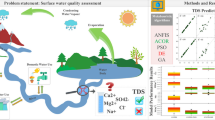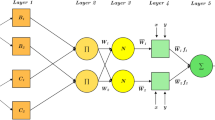Abstract
Water quality management and control has high importance in planning and developing of water resources. This study investigated application of Genetic Algorithm (GA), Ant Colony Optimization for Continuous Domains (ACOR) and Differential Evolution (DE) in improving the performance of adaptive neuro-fuzzy inference system (ANFIS), for evaluating the quality parameters of Gorganroud River water, such as Electrical Conductivity (EC), Sodium Absorption Ratio (SAR) and Total Hardness (TH). Accordingly, initially most suitable inputs were estimated for every model using sensitivity analysis and then all of the quality parameters were predicted using mentioned models. Investigations showed that for predicting EC and TH in test stage, ANFIS-DE with R2 values of 0.98 and 0.97, respectively and RMSE values of 73.03 and 49.55 and also MAPE values of 5.16 and 9.55, respectively were the most appropriate models. Also, ANFIS-DE and ANFIS-GA models had the best performance in prediction of SAR (R2 = 0.95, 0.91; RMSE = 0.43, 0.37 and MAPE = 13.43, 13.72) in test stage. It is noteworthy that ANFIS showed the best performance in prediction of all mentioned water quality parameters in training stage. The results indicated the ability of mentioned algorithms in improving the accuracy of ANFIS for predicting the quality parameters of river water.
Similar content being viewed by others
References
Ay, M. and Kisi, O. (2016). “Estimation of dissolved oxygen by using neural networks and neuro fuzzy computing techniques.” KSCE Journal of Civil Engineering, pp. 1–9, DOI: 10.1007/s12205-016-0728-6.
Basser, H., Karami, H., Shamshirband, S., Jahangirzadeh, A., Akib, S., and Saboohi, H. (2014). “Predicting optimum parameters of a protective spur dike using soft computing methodologies–A comparative study.” Computers & Fluids, vol. 97, pp. 168–176.
Chan, F. and Chung, S. (2004). “Multi-criteria genetic optimization for distribution network problems.” The International Journal of Advanced Manufacturing Technology, vol. 24, no. 7, pp. 517–532, DOI: 10.1007/s00170-002-1445-5.
Chiu, S. (1994). “Fuzzy model identification based on cluster estimation.” Journal of Intelligent and Fuzzy Systems, vol. 2, no. 3, pp. 267–278, DOI: 10.3233/IFS-1994-2306.
Deb, K. A. P., Agarwal, S., and Meyarivan, T. (2000). “A fast elitist multi-objective Genetic Algorithm for multi-objective optimization: NSGA-II.” International Conference on Parallel Problem Solving From Nature, pp. 849–858, DOI: 10.1007/3-540-45356-3_83.
Dehghani, A. A., Asgari, M., and Mosaedi, A. (2009). “Comparison of Geostatistics, Artifitial Neural Networks and Adaptive Neuro-Fuzzy Inference System Approaches in Groundwater Level Interpolation (Case study: Ghazvin aquifer).” Journal of Agriculture Science Natural Resource, vol. 16, no. 1, pp. 517–528.
Dorigo, M. (1992). Optimization, Learning and Natural Algorithms, PhD Thesis, Dipartimento di Elettronica, Politecnico di Milano, Italy.
Emamgholizadeh, S., Kashi, H., Marofpoor, I., and Zalaghi, E. (2014). “Prediction of water quality parameters of Karoon River (Iran) by artificial intelligence-based models.” International Journal of Environmental Science and Technology, vol. 11, no. 3, pp. 645–656, DOI: 10.1007/s13762-013-0378-x.
Esmaeili-Varaki, M., Khayat-Khalaghi, M., and Shafiei, M. (2004). “Provide a Model for Intelligent Water Level Fluctuations Estimated Alluvial Groundwater Aquifer Using an Artificial Neural Network.” Articles First Annual Conference of Iran Water Resources Management, pp. 1–11.
Galavi, H. and Shui, L. T. (2012). “Neuro-fuzzy modelling and forecasting in water resources.” Scientific Research and Essays, vol. 7, no. 24, pp. 2112–2121.
Holland, J. H. (1975). Adaption in natural and artificial system, The University of Michigan Press.
Hosseini, M. and Javadi-Moghaddam, J. (2014). “Determination of water quality parameters and nutrient level with an Adaptive Neuro-Fuzzy Inference System.” Journal of Physical and Theoretical Chemistry, vol. 11, no. 1, pp. 29–37.
Jajarmizadeh, M., Kakaei-Lafdani, E., Harun, S., and Ahmadi, A. (2014). “Application of SVM and SWAT Models for monthly streamflow prediction, A case study in South of Iran.” KSCE Journal of Civil Engineering, Vol. 19. No. 1, pp. 345–357, DOI: 10.1007/s12205-014-0060-y.
Jaramillo, J., Bhadury, J., and Batta, R. (2002). “On the use of genetic algorithms to solve location problems.” Computers & Operations Research, Vol 29, no. 6, pp. 761–779.
Jang, J. S. R. (1993). “ANFIS: Adaptive-network-based fuzzy inference system. Systems.” IEEE Transactions on Systems, Man, and Cybernetics, Vol. 23. No. 3, pp. 665–685.
Jalalkamali, A. (2015). “Using of hybrid fuzzy models to predict spatiotemporal groundwater quality parameters.” Earth Science Informatics, vol. 8, no. 4, pp. 885–894.
Karami, H., Hosseinjanzadeh, H., Hosseini, K., and Ardeshir, A. (2017). “Scour and three-dimensional flow field measurement around short vertical-wall abutment protected by collar.” KSCE Journal of Civil Engineering, pp. 1–12.
Khadr, M. and Elshemy, M. (2016). “Data-driven modeling for water quality prediction case study: The drains system associated with Manzala Lake, Egypt.” Ain Shams Engineering Journal, DOI: 10.1016/j.asej.2016.08.004.
Kholghi, M. and Hosseini, S. M. (2007). “Comparison of groundwater level estimation using neurofuzzy and ordinary kriging.” Invironmental Modeling & Assessment, vol. 14, no. 6, pp. 729–737.
Kuo, Y., Liu, C., and Lin, K. H. (2004). “Evaluation of the ability of an artificial neural network model to assess the variation of groundwater quality in an area of black foot disease in Taiwan.” Water Research, vol. 38, no. 1, pp. 148–58.
Kuo, J., Hsieh, M., Lung, W., and She, N. (2007). “Using artificial neural network for reservoir eutriphication prediction.” Ecological Modelling, vol. 200, no. 1, pp. 171–177.
Little, k, w. and Williams, R, E. (1992). “Least-square calibration of QUAL2E.” Water Environment Research, vol. 64, no. 2, pp. 179–185.
Lallahem, S., Mania, J., Hani, A., and Najjar, Y. (2005). “On the use of neural networks to evaluate groundwater levels in fracturedmedia.” Journal of Hydrology, vol. 307, no. 1, pp. 92–111.
Mousavi, S, F. and Amiri, M. J. (2012). “Modelling nitrate concentration of groundwater using adaptive neural-based fuzzy inference system.” Soil Water Resour, vol. 7, no. 2, pp. 73–83.
Najah, A., EL-Shafie, A., Karim, A., and EL-Shafie, A. H. (2014). “Performance of ANFIS versus MLP-NN dissolved oxygen prediction models in water quality monitoring.” Environmental Science and Pollution Research, vol. 21, no. 3, pp. 1658–1670.
Noori, R., Karbassi, A., Khakpour, A., Shahbazbegian, M., Mohammadi Khalf Badam, H., and Vesali-Naseh, M. (2012). “Chemometric analysis of surface water quality data: Case study of the gorganroodriver basin, Iran.” Environmental Modeling & Assessment, vol. 17, no. 4, pp. 411–420.
Orouji, H., Bozorg-Haddad, O., Fallah-Mehdipour, E., and Mariño, M. A. (2013). “Modeling of water quality parameters using data-driven models.” Journal of Environmental Engineering, ASCE, vol. 139, no. 7, pp. 947–957, DOI: 10.1061/(ASCE) EE.1943-7870.0000706.
Ostad-Ali-Askari, K., Shayannejad, M., and Ghorbanizadeh-Kharazi, H. (2016). “Artificial neural network for modeling nitrate pollution of groundwater in marginal area of zayandeh-rood river, Isfahan, Iran.” KSCE Journal of Civil Engineering, vol. 21, no. 1, pp. 134–140, DOI: 10.1007/s12205-016-0572-8.
Patel, J. S. and Singh, S. S. (2014). “Modelling COD and DO concentration by using Adaptive Neure-Fuzzy Inference system (ANFIS).” Indian Journal of Applied Research, vol. 4, no. 11, pp. 5–8.
Peyghami, M. R. and Khanduzi, R. (2013). “Novel MLP neural network with hybrid Tabu search algorithm.” Neural Network World, vol. 3, no. 13, pp. 255–270.
Price, K. and R. Storn. (1995). Differential evolution-a simple and efficient adaptive scheme for global optimization over continuous spaces, Technical report, International Computer Science Institute.
Tabari, M. M. R. (2016). “Prediction of river runoff using fuzzy theory and direct search optimization algorithm coupled model.” Arabian Journal for Science and Engineering, Vol. 41. No. 10, pp. 4039–4051, DOI: 10.1007/s13369-016-2081-y.
Saharia, M. and Bhattacharjya, R. K. (2011). Geomorphology-based time-lagged recurrent neural networks for runoff forecasting.” KSCE Journal of Civil Engineering, vol. 16, no. 5, pp. 862–869, DOI: 10.1007/s12205-012-1463-2.
Seyam, M. and Mogheir, Y. (2011). “A new approach for groundwater quality management.” Islam Univ J (Series of Natural Studies and Engineering), vol. 19, no. 1, pp. 157–177.
Shamim, M. A., Hassan, M., Ahmad, S., and Zeeshan, M. (2015). “A Comparison of Artificial Neural Networks (ANN) and Local Linear Regression (LLR) Techniques for predicting monthly reservoir levels.” KSCE Journal of Civil Engineering, vol. 20, no. 2, pp. 971–977, DOI: 10.1007/s12205-015-0298-z.
Socha, K. and Dorigo, M. (2008). “Ant colony optimization for continuous domains.” European Journal of Operational Research, vol. 185, no. 3, pp. 1155–1173.
The deputy of planning, Ministry of Interior (2007). Environmental Monitoring and management planning of Gorganrood River, The university of Agricultural sciences and natural resources of Gorgan.
Zadeh, L. A. (1965). “Fuzzy sets.” Information and Control, vol. 8, no. 3, pp. 338–353.
Zhou, G., Min, H., and Gen, M. (2003). “A genetic algorithm approach to the bi-criteria allocation of ustomers to warehouses.” International Journal of Production Economics, vol. 86, no. 1, pp. 35–45.
Zhou, C. H., Gao, L., Gao, H., and Chuanyong, P. (2006). “Pattern classification and prediction of water quality by neural network with particle swarm optimization.” Proceeding of the 6th world Congress on Control and Automation, Jun, Dalian, China, pp. 21–23.
Author information
Authors and Affiliations
Corresponding author
Rights and permissions
About this article
Cite this article
Azad, A., Karami, H., Farzin, S. et al. Prediction of Water Quality Parameters Using ANFIS Optimized by Intelligence Algorithms (Case Study: Gorganrood River). KSCE J Civ Eng 22, 2206–2213 (2018). https://doi.org/10.1007/s12205-017-1703-6
Received:
Revised:
Accepted:
Published:
Issue Date:
DOI: https://doi.org/10.1007/s12205-017-1703-6




